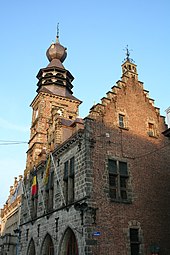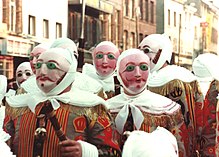Binche
| Binche | ||
|---|---|---|

|

|
|
|
|
||
| State : |
|
|
| Region : | Wallonia | |
| Province : | Hainaut | |
| District : | La Louvière | |
| Coordinates : | 50 ° 25 ′ N , 4 ° 10 ′ E | |
| Area : | 60.66 km² | |
| Residents: | 33,473 (Jan 1, 2019) | |
| Population density: | 552 inhabitants per km² | |
| Height: | 130 m | |
| Post Code: | 7130, 1731, 1733, 1734 | |
| Prefix: | 064 | |
| Mayor: | Laurent Devin ( PS ) | |
Local government address : |
Rue Saint-Paul, 14 7130 Binche |
|
| Website: | www.binche.be | |
Binche is a municipality in the Belgian province of Hainaut in Wallonia . In 1977 the municipalities of Bray, Buvrinnes, Epinois, Leval-Trahegnies, Péronnes-lez-Binche, Ressaix and Waudrez were merged with Binche.
history
The city was founded in the 12th century by Yolande von Geldern, widow of Duke Baldwin III. of Hainaut. Their son Baldwin IV fortified the city, which, like Maubeuge and Le Quesnoy, served as a border fortress against France .
In the 14th century the city wall was expanded to its present size.
In 1409 the relics of St. Ursmar were brought to Binche from Lobbes Abbey in the Principality of Liège . The Notre Dame church became the Saint-Ursmer collegiate church.
The city's prosperity reached its peak under Emperor Charles V , who among other things also carried the title of Duke of Hainaut. His sister Maria of Hungary , after the death of her husband Ludwig II of Bohemia and Hungary , ruled as governor of the Netherlands and stayed in Binche several times. A magnificent Renaissance palace dates from this period.
In 1554 the period of this prosperity came to an end: the palace, the city and the surrounding area were sacked by the troops of King Henry II of France . Until the beginning of the 18th century, Hainaut was the site of repeated military conflicts between the kingdoms of France and Spain.
Only with the industrial revolution did prosperity increase again. Coal pits were built, the heaps of which still characterize the landscape today. Then there were brickworks, tanneries, glaziers, breweries, lime kilns and soap factories. Thousands of people worked from home as lace makers , cobblers and tailors. The post office and the train station date from this time.
After the Second World War , the city was dominated by the textile industry. With its decline in the 1970s, the city's prosperity fell again.
Attractions
carnival
The Binche Carnival is the city's most famous event. In 2003 it was included by UNESCO in the list of Masterpieces of the Oral and Intangible Heritage of Humanity (since 2008 Representative List of the Intangible Cultural Heritage of Humanity ). It is similar to the Alemannic carnival . The first move took place in 1395. The fact that the first parade allegedly took place in 1549, when the already mentioned Maria of Hungary allowed court ladies disguised as Inca to march through the streets in honor of her brother, where real Indians are said to have been present, is now considered untenable in research.
Belfry
The 14th century belfry of Binche town hall is part of the UNESCO World Heritage “ Belfries in Belgium and France ”.
additional
- In the collegiate church of Saint-Ursmer from the 12th to 15th centuries there is a wooden Pietà from 1511.
- Remains of the former city fortifications can still be seen in the city.
- In Binche there is the International Carnival and Mask Museum .
Sports
From 1911 to 1996 the Binche – Tournai – Binche cycling race was held with interruptions . It has been held again since 2010, in the UCI category 1.1., And bears the name Mémorial Frank Vandenbroucke in memory of the Belgian cyclist who died in 2009.
sons and daughters of the town
- Louis Canivez (1837–1911), composer and conductor
- Omer Taverne (1904–1981), cyclist, born in Waudrez
literature
- Markus Tauschek: Value creation from tradition: the Carnival of Binche and the constitution of cultural heritage (= studies on cultural anthropology, European ethnology , volume 3). Lit, Berlin (among others) 2010, ISBN 978-3-643-10266-9 (Dissertation Uni Göttingen 2009).
Web links
- Official website of the municipality (French)
- carnival
- Carnival Mask Museum
- Illustration by Frans Hogenberg from 1578: How the Hertzog Alonci conquered the Statt Bins ( digitized version )
Footnotes
- ↑ Julian Mieth: Belgium's most famous carnival: jokes with bubbly . In: Spiegel Online . February 22, 2012



